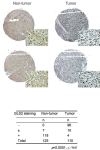Glutaminase 2 negatively regulates the PI3K/AKT signaling and shows tumor suppression activity in human hepatocellular carcinoma
- PMID: 24797434
- PMCID: PMC4058033
- DOI: 10.18632/oncotarget.1862
Glutaminase 2 negatively regulates the PI3K/AKT signaling and shows tumor suppression activity in human hepatocellular carcinoma
Abstract
The tumor suppressor p53 and its signaling pathway play a critical role in tumor prevention. As a direct p53 target gene, the role of glutaminase 2 (GLS2) in tumorigenesis is unclear. In this study, we found that GLS2 expression is significantly decreased in majority of human hepatocellular carcinoma (HCC). Restoration of GLS2 expression in HCC cells inhibits the anchorage-independent growth of cells and reduces the growth of HCC xenograft tumors. Interestingly, we found that GLS2 negatively regulates the PI3K/AKT signaling, which is frequently activated in HCC. Blocking the PI3K/AKT signaling in HCC cells largely abolishes the inhibitory effect of GLS2 on the anchorage-independent cell growth and xenograft tumor growth. The GLS2 promoter is hypermethylated in majority of HCC samples. CpG methylation of GLS2 promoter inhibits GLS2 transcription, whereas reducing the methylation of GLS2 promoter induces GLS2 expression. Taken together, our results demonstrate that GLS2 plays an important role in tumor suppression in HCC, and the negative regulation of PI3K/AKT signaling contributes greatly to this function of GLS2. Furthermore, hypermethylation of GLS2 promoter is an important mechanism contributing to the decreased GLS2 expression in HCC.
Conflict of interest statement
The authors declare no conflict of interest.
Figures







Similar articles
-
FAM9C plays an anti-apoptotic role through activation of the PI3K/Akt pathway in human hepatocellular carcinoma.Oncol Rep. 2013 Sep;30(3):1275-84. doi: 10.3892/or.2013.2592. Epub 2013 Jul 5. Oncol Rep. 2013. PMID: 23836295
-
MicroRNA-105 suppresses cell proliferation and inhibits PI3K/AKT signaling in human hepatocellular carcinoma.Carcinogenesis. 2014 Dec;35(12):2748-55. doi: 10.1093/carcin/bgu208. Epub 2014 Oct 3. Carcinogenesis. 2014. PMID: 25280563
-
DNA methylation-mediated silencing of Neuronatin promotes hepatocellular carcinoma proliferation through the PI3K-Akt signaling pathway.Life Sci. 2023 Jan 1;312:121266. doi: 10.1016/j.lfs.2022.121266. Epub 2022 Dec 5. Life Sci. 2023. PMID: 36473542
-
Biological impact and therapeutic perspective of targeting PI3K/Akt signaling in hepatocellular carcinoma: Promises and Challenges.Pharmacol Res. 2023 Jan;187:106553. doi: 10.1016/j.phrs.2022.106553. Epub 2022 Nov 15. Pharmacol Res. 2023. PMID: 36400343 Review.
-
Non-coding RNA mediated regulation of PI3K/Akt pathway in hepatocellular carcinoma: Therapeutic perspectives.Pathol Res Pract. 2024 Jun;258:155303. doi: 10.1016/j.prp.2024.155303. Epub 2024 Apr 27. Pathol Res Pract. 2024. PMID: 38728793 Review.
Cited by
-
An African-specific polymorphism in the TP53 gene impairs p53 tumor suppressor function in a mouse model.Genes Dev. 2016 Apr 15;30(8):918-30. doi: 10.1101/gad.275891.115. Epub 2016 Mar 31. Genes Dev. 2016. PMID: 27034505 Free PMC article.
-
Structure and activation mechanism of the human liver-type glutaminase GLS2.Biochimie. 2021 Jun;185:96-104. doi: 10.1016/j.biochi.2021.03.009. Epub 2021 Mar 18. Biochimie. 2021. PMID: 33746066 Free PMC article.
-
Development of a ferroptosis-based model to predict prognosis, tumor microenvironment, and drug response for lung adenocarcinoma with weighted genes co-expression network analysis.Front Pharmacol. 2022 Nov 17;13:1072589. doi: 10.3389/fphar.2022.1072589. eCollection 2022. Front Pharmacol. 2022. PMID: 36467089 Free PMC article.
-
Glutaminase 2 functions as a tumor suppressor gene in gastric cancer.Transl Cancer Res. 2020 Aug;9(8):4906-4913. doi: 10.21037/tcr-20-2246. Transl Cancer Res. 2020. PMID: 35117852 Free PMC article.
-
GLS2 is protumorigenic in breast cancers.Oncogene. 2020 Jan;39(3):690-702. doi: 10.1038/s41388-019-1007-z. Epub 2019 Sep 20. Oncogene. 2020. PMID: 31541193
References
-
- Levine AJ, Hu W, Feng Z. The P53 pathway: what questions remain to be explored? Cell Death Differ. 2006;13(6):1027–1036. - PubMed
-
- Vousden KH, Prives C. Blinded by the Light: The Growing Complexity of p53. Cell. 2009;137(3):413–431. - PubMed
-
- Greenblatt MS, Bennett WP, Hollstein M, Harris CC. Mutations in the p53 tumor suppressor gene: clues to cancer etiology and molecular pathogenesis. Cancer Res. 1994;54(18):4855–4878. - PubMed
-
- Staib F, Hussain SP, Hofseth LJ, Wang XW, Harris CC. TP53 and liver carcinogenesis. Hum Mutat. 2003;21(3):201–216. - PubMed
Publication types
MeSH terms
Substances
Grants and funding
LinkOut - more resources
Full Text Sources
Other Literature Sources
Medical
Research Materials
Miscellaneous

